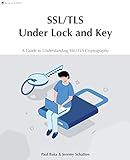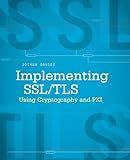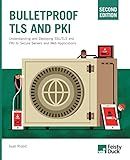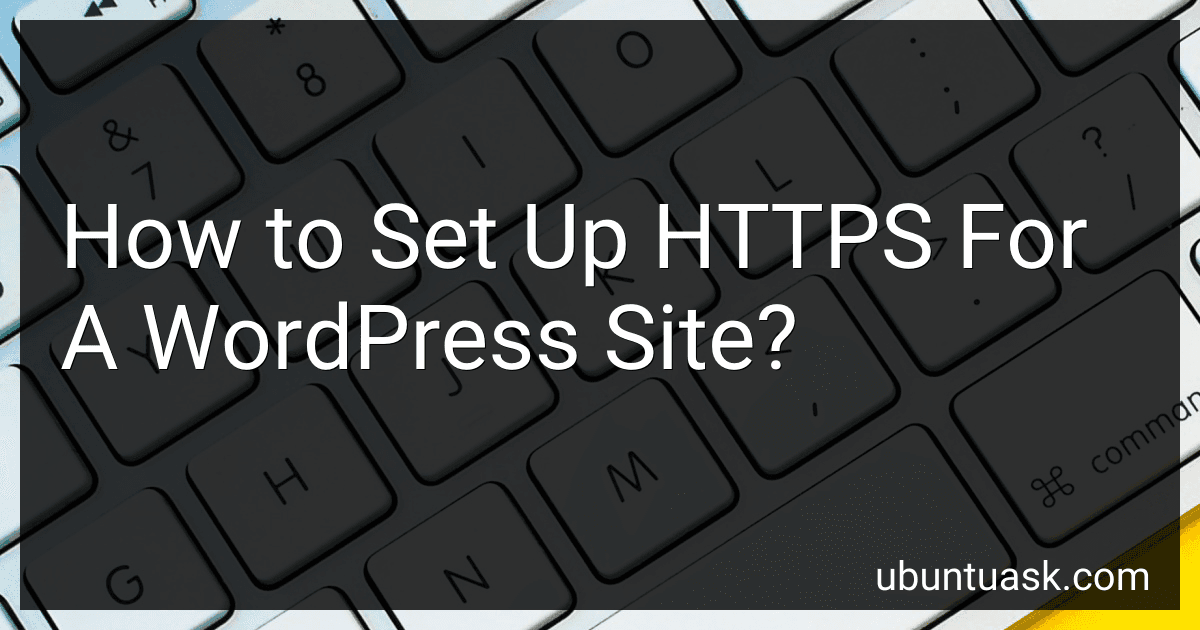Best Security Tools to Buy in December 2025

SSL/TLS Under Lock and Key: A Guide to Understanding SSL/TLS Cryptography



Implementing SSL / TLS Using Cryptography and PKI



FREE SSL CERTIFICATES: Secure your Web server with free Let's Encrypt Certificates Guide to fully automate the process of creating and renewing certificates. (CTS SOLUTIONS IT-PRO E-Books Book 4)



Bulletproof TLS and PKI, Second Edition: Understanding and Deploying SSL/TLS and PKI to Secure Servers and Web Applications



SSL server certificate creation manual for CentOS 8/7 (Japanese Edition)



IIS Essentials: From Installation to Maintenance - The Ultimate Guide: Unleashing the Power of Your Web Server



$15M Line Item That Doesn't Exist: The Invisible Certificate Management Tax and How Automation Eliminates 95% of It (Your Infrastructure Intelligence Book 3)



Mastering NGINX Second Edition



Secure Your WordPress Website with HTTPS for free: A Visual Step-by-Step Guide to Securing Your Website with SSL (Webmaster Series)


To set up HTTPS (Hypertext Transfer Protocol Secure) for a WordPress site, follow the steps below:
- Get an SSL Certificate: Purchase an SSL certificate from a trusted certificate authority or obtain a free SSL certificate from Let's Encrypt.
- Install SSL Certificate: Contact your hosting provider or refer to their documentation to install the SSL certificate on your server. This usually involves generating a certificate signing request (CSR) and providing it to your hosting provider, who will then install the SSL certificate for you.
- Update WordPress Settings: Log in to your WordPress admin area. From the left sidebar, go to "Settings" and then "General." Update the WordPress Address (URL) and Site Address (URL) to start with "https://" instead of "http://". Save the settings.
- Update Internal Links: Use a plugin like Better Search Replace or Velvet Blues Update URLs to update all internal links across your website from "http://" to "https://". This ensures that all content is loaded securely.
- Update External and Embedded Content: Manually update any external or embedded content, such as images, videos, or scripts, to use secure URLs. Change "http://" to "https://" in the HTML or update the source URLs.
- Redirect HTTP to HTTPS: Redirect all HTTP traffic to HTTPS to ensure that visitors always access the secure version of your site. Add the following code to your .htaccess file:
<IfModule mod_rewrite.c> RewriteEngine On RewriteCond %{HTTPS} off RewriteRule ^(.*)$ https://%{HTTP_HOST}%{REQUEST_URI} [L,R=301]
- Test and Verify: Test your website to make sure all pages load over HTTPS and there are no mixed content warnings. Use tools like Why No Padlock or SSL Labs SSL Server Test to check for any SSL related issues.
By following these steps, you can successfully set up HTTPS for your WordPress site, improving security and privacy for your visitors.
How to redirect HTTP to HTTPS in WordPress?
To redirect HTTP to HTTPS in WordPress, you can follow these steps:
- Install and activate the "Really Simple SSL" plugin from the WordPress plugin repository.
- After activation, the plugin will automatically detect your SSL certificate and enable SSL on your website. It will also update your site URL to HTTPS.
- The plugin will add the necessary code to your ".htaccess" file to redirect HTTP to HTTPS. In case it doesn't, you can manually add the following code at the top of your ".htaccess" file:
<IfModule mod_rewrite.c> RewriteEngine On RewriteCond %{HTTPS} off RewriteRule ^(.*)$ https://%{HTTP_HOST}%{REQUEST_URI} [L,R=301]
- Save the changes to your ".htaccess" file and upload it to your website's root directory using an FTP client or file manager provided by your web hosting provider.
- Clear any caching plugin you might have installed to ensure the changes take effect immediately.
After following these steps, your WordPress website will automatically redirect all HTTP requests to HTTPS.
What is the impact of using HTTPS on website performance?
Using HTTPS can have a minimal impact on website performance, but it ultimately depends on a variety of factors. Here are some potential impacts:
- Encrypted Connection: HTTPS encrypts the data transmitted between the user's browser and the web server, which increases the time and computational resources required for encryption and decryption. However, modern encryption algorithms have become faster, making this impact negligible for most websites.
- Handshake Latency: When establishing an HTTPS connection, a handshake process occurs between the client and the server to verify identities and negotiate encryption. This involves additional round trips, which can slightly increase the initial connection latency.
- SSL/TLS Handshake: When using HTTPS, the client and server perform an SSL/TLS handshake, which involves computation-intensive operations. This handshake may cause some delay during the initial connection setup.
- Content Caching: Some older web proxies and caching servers do not cache content delivered via HTTPS, as they may not reliably store encrypted content. This can impact site performance for users accessing the website through such intermediaries.
- HTTP/2: Enabling HTTPS is often done in conjunction with using the HTTP/2 protocol, which can significantly improve website performance. HTTP/2 allows for multiplexing and server push, reducing the number of round trips and optimizing content delivery.
- Third-Party Content: If a website includes third-party resources (such as ads, images, or scripts) that are not served via HTTPS, some web browsers may display warning messages or block these resources. This can affect the overall user experience and website performance.
Overall, the performance impact of using HTTPS has decreased over time, and the security and privacy benefits it provides outweigh the minor latency introduced.
How to force HTTPS in WordPress using a plugin?
To force HTTPS in WordPress using a plugin, you can follow these steps:
- Install and activate an SSL plugin like "Really Simple SSL" or "WordPress HTTPS SSL Plugin" from the WordPress Plugin Directory.
- Once activated, the plugin will automatically detect your SSL certificate and configure your website to run over HTTPS. It will also update all the site URLs from HTTP to HTTPS.
- However, it's important to double-check the settings. Usually, you can find the plugin settings under "Settings" or "Tools" in your WordPress dashboard.
- Configure any additional options or features provided by the plugin. For example, you may have options to enable HTTP to HTTPS redirection or fix any mixed content issues (HTTP resources embedded in HTTPS pages).
- Save your changes.
- Visit your website to ensure that it is now using HTTPS. You should see a secure padlock icon in the browser's address bar.
Keep in mind that using a plugin to force HTTPS can sometimes conflict with other plugins or themes. If you encounter any issues, you may need to troubleshoot or seek additional support from the plugin's developer or a WordPress community forum.
What precautions should be taken before enabling SSL on a WordPress site?
Before enabling SSL on a WordPress site, some precautions to take include:
- Backup your website: Before making any changes, it's important to backup your WordPress site to ensure you have a copy of all your files and database.
- Check compatibility: Ensure that your WordPress theme, plugins, and any third-party services you use are compatible with SSL. Some plugins or themes may require updates or cause compatibility issues with SSL, so it's essential to check for any known issues or updates.
- Choose a trusted SSL certificate: Select a reliable SSL certificate from a trusted certificate authority (CA). There are several types of SSL certificates available, such as domain validated (DV), organization validated (OV), and extended validation (EV) certificates. Choose the one that best fits your needs.
- Purchase or obtain SSL certificate: Purchase an SSL certificate or get one from your web hosting provider. Some hosting providers offer free SSL certificates through services like Let's Encrypt.
- Install SSL certificate: Follow your hosting provider's instructions to install the SSL certificate on your server. This may involve generating a certificate signing request (CSR) and providing the SSL certificate to your hosting provider.
- Update WordPress settings: Change the site URL in the WordPress settings to include 'https://' instead of 'http://'. This ensures all internal links and resources are loaded securely.
- Update website content and plugins: Ensure that all internal links within your website are updated to use 'https://' instead of 'http://'. Additionally, update any hardcoded URLs in your theme, plugins, or custom code. Many plugins can help automate this process.
- Test the SSL setup: Use online tools like SSL Labs or Why No Padlock to check if your SSL certificate is correctly installed and configured. Verify that all pages load securely without any mixed content warnings.
- Implement HTTP to HTTPS redirects: Set up proper HTTP to HTTPS redirects to ensure that all visitors are automatically redirected to the secure version of your site. This can be done using server configurations or through WordPress plugins.
- Test and validate: After enabling SSL, thoroughly test your website to ensure everything is functioning correctly. Test different pages, forms, and media files to ensure they load securely.
- Update external services: Update any external services or APIs you use to communicate over an insecure connection (HTTP) to use the new secure connection (HTTPS). This includes third-party integrations, CDN services, email services, etc.
By following these precautions, you can ensure a smooth and secure transition to SSL on your WordPress site.
How to manage mixed content warnings after implementing HTTPS on a WordPress site?
After implementing HTTPS on a WordPress site, you may encounter mixed content warnings that indicate some resources on your page are being loaded over an insecure HTTP connection. To manage these warnings, follow these steps:
- Identify mixed content: Browse your website and use the browser's developer tools to identify resources (such as images, scripts, or stylesheets) being loaded over HTTP instead of HTTPS. Look for warnings or errors in the console.
- Update internal links: Go through your website's pages and posts, updating any internal links from HTTP to HTTPS. This includes editing image sources, script or stylesheet file paths, and any other resources loaded internally.
- Update hardcoded URLs: If you have hardcoded URLs in your theme files or plugins, update them to use HTTPS instead of HTTP. Common places to check include header.php, footer.php, and any custom plugins or functions that generate HTML output.
- Use a plugin: WordPress has several plugins available to help with the migration to HTTPS. Some popular options include Really Simple SSL, SSL Insecure Content Fixer, and Better Search Replace. These plugins can automatically update URLs across your website or provide tools to fix mixed content issues.
- Update external resources: If your website includes resources (such as images, scripts, or fonts) hosted externally, check if those resources are available over HTTPS. If they are, update the URLs to use HTTPS. If they are not available over HTTPS, consider finding alternative resources or contacting the third-party source to request HTTPS support.
- Enable Content Security Policy (CSP): Implementing a Content Security Policy can help protect your website against mixed content warnings and other security-related issues. CSP allows you to specify which sources your website can load content from, reducing the risk of loading insecure resources.
- Test and monitor: After making the necessary updates, thoroughly test your website across different browsers and devices to ensure all mixed content warnings are resolved. Regularly monitor your website for any new warnings or issues that may arise.
Remember, SSL certificates and HTTPS implementation only secure the connection between your website and the user's browser. Ensuring all resources are loaded over HTTPS is crucial for a completely secure browsing experience.
How to check if a WordPress site is using HTTPS or HTTP?
To check if a WordPress site is using HTTPS or HTTP, you can follow these steps:
- Visit the website in your web browser.
- Look at the URL in the address bar. If the URL starts with "https://" then the site is using HTTPS. If it starts with "http://" then it is using HTTP.
Alternatively, you can use the following methods:
- Inspect Page Source: Right-click anywhere on the webpage, select "Inspect" or "Inspect element" to open the browser's developer tools. Look for the line in the source code. If the href value starts with "https://" then it is using HTTPS.
- WordPress Dashboard: Log in to the WordPress admin area of the website. In the left sidebar, go to "Settings" and then "General." Look for the "WordPress Address (URL)" and "Site Address (URL)" fields. If the URLs start with "https://" then the site is using HTTPS.
Please note that these methods may vary slightly depending on the specific WordPress theme or plugins installed on the website.
